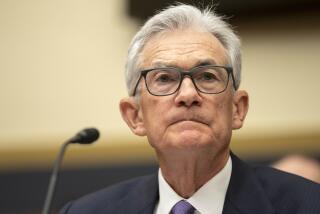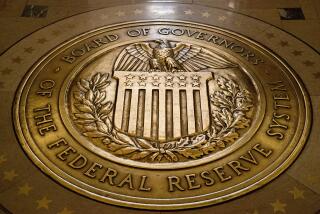Fed expected to unveil plans for another stimulus program
WASHINGTON — Federal Reserve Chairman Ben S. Bernanke is poised to roll out another stimulus program — and risk the wrath of conservative critics.
Bernanke and his central bank colleagues gather Wednesday for a pivotal two-day session fresh off last week’s disappointing jobs report, the latest in a string of signs that the economic recovery is faltering.
And with Europe, China and other nations taking steps to bolster their struggling economies in the face of a global slowdown, Washington and Wall Street expect the Fed to unveil plans for a third round of its controversial bond-buying program when the meeting ends Thursday.
Economists said the move could help boost the economy if the Fed focuses its efforts on the slowly improving housing market. By buying mortgage-backed securities, it could edge down already historically low borrowing rates.
Lower rates also could make banks more likely to lend because it would be easier to sell the loans to the Fed and avoid risks of losses. That, in turn, could help stimulate economic activity and help create jobs.
“There’s a bigger bang for the dollar when you’re hitting a market that’s already showing signs of healing,” said Diane Swonk, chief economist with Mesirow Financial.
Given expectations of some action, the Fed could trigger a market sell-off if it opts to do nothing.
“It would be a pretty big disappointment if the Fed did not act at this stage of the game,” Swonk said. “The employment report was the game changer.”
There are downsides to another round of so-called quantitative easing.
Lower interest rates hit elderly Americans hard by reducing the income they could draw from their savings, particularly certificates of deposit.
“It’s badly pinching seniors who rely on CDs,” said James Chessen, executive vice president of the American Bankers Assn., an industry trade group.
And those low rates, which the Fed has promised to extend at least through 2014, could be keeping businesses from borrowing now because they know they’ll have access to cheap money for a long time.
The previous two rounds of bond buying have caused the Fed’s balance sheet to more than triple to $2.8 trillion over the last four years, angering Republicans and fueling a conservative movement to dismantle the central bank.
Launching a stimulus program in the weeks before a presidential election also could lead Congress to take steps to rein in the Fed’s authority, said Gregory D. Hess, an economics professor at Claremont McKenna College.
A new round of bond buying could be “another shovel full of dirt as the Fed digs its own grave as a politically independent institution,” he said.
But with the economy still struggling to create jobs, Bernanke and other Fed officials have signaled that they’re ready to act. And though short-term interest rates are near zero, another large-scale bond-buying effort would be the central bank’s main weapon.
After the government reported last week that the economy added just 96,000 jobs in August, economists polled by Reuters said there was a 60% chance the Fed would launch another round of bond buying.
The first round, from March 2009 to March 2010, involved the purchase of $1.25 trillion in mortgage-backed securities, along with $200 billion in debt issued by government-backed agencies such as Fannie Mae and $300 billion in longer-term Treasury securities.
With the economy still struggling in November 2010, the Fed launched a second round of quantitative easing, purchasing $600 billion in Treasury securities through June 2011.
Arvind Krishnamurthy, a finance professor at Northwestern University, said mortgage bond purchases have more effect on consumer interest rates than the purchase of Treasury securities. A new Fed program focused on mortgage-backed securities could lower mortgage rates by about 0.25 of a percentage point, he said.
Freddie Mac said last week that the typical 30-year fixed rate for mortgages was 3.55%.
If the Fed opts for more stimulus, the key factors will be what type of bonds it decides to buy, how much will be spent and over what time period. Swonk predicted the Fed would focus on mortgage bonds but would not give any other parameters to allow for maximum flexibility.
By increasing demand, mortgage-bond purchases drive down the interest rates that those securities offer investors. That means home lenders could lower the rates on loans that wind up in the pools backing the mortgage securities — the destination for nearly all longer-term loans these days.
Lower rates make home purchases more affordable, supporting the troubled housing market, and enable homeowners to refinance into loans with lower payments, stimulating the economy by leaving more money in their pockets to spend on other items.
Lowering the rate for a $350,000 mortgage to 3.5% from about 6% some four years ago would cut the monthly payment to $1,571.66 from $2,098.43, saving the borrower more than $6,000 a year.
Mortgage analysts, however, said the effect for consumers has been damped as rates have sunk to unprecedented lows.
A May study by Michael D. Bauer, an economist with the Federal Reserve Bank of San Francisco, found that rates on mortgage securities declined much more than rates on the loans themselves.
Banks making the loans “aren’t passing it on to consumers,” said Scott Simon, head of the mortgage-backed securities team at Pimco, the giant Newport Beach bond trading firm. “Rather, they are making even more money.”
Although Wells Fargo & Co. and JPMorgan Chase & Co. have expanded home lending in recent years, many other players burned by the mortgage meltdown, including Citigroup Inc. and Bank of America Corp., have retrenched. And the number of independent mortgage brokers has dropped sharply as well amid tighter regulation.
The effect has been to shrink the availability of home loans at a time of high demand.
“There isn’t a lot of competition as the industry is near capacity,” Simon said. “If you are a restaurant with 100 people waiting, you really don’t need to lower prices.”
Hess said the economic effect of more bond buying would be minimal.
“People on the edge of refinancing might find there’s a slight benefit,” he said. “It’s a small positive.”
Also at its meeting, the Fed is expected to extend the period it intends to keep short-term interest rates near zero into 2015.
But Chessen said the Fed’s “abnormally low rates” are discouraging businesses — already worried by the European debt crisis, the slowing global economy and the uncertain U.S. recovery — from taking risks that would help heal the economy.
“Businesses have no urgency to borrow because they know rates will be low for so long,” Chessen said.
Puzzanghera reported from Washington; Reckard from Orange County.








